2015 NISSAN GT-R key battery
[x] Cancel search: key batteryPage 141 of 358
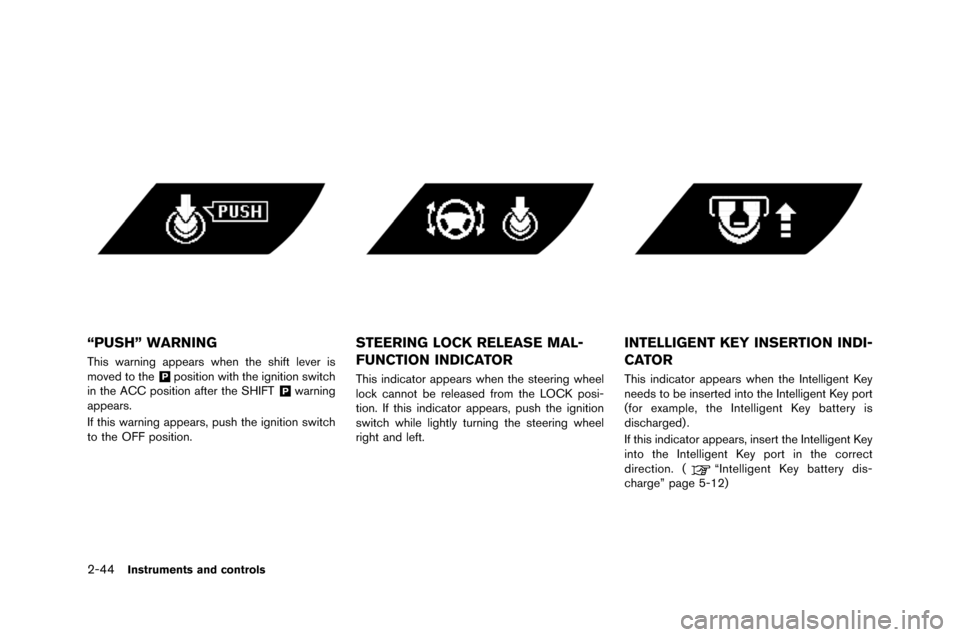
2-44Instruments and controls
“PUSH” WARNING
This warning appears when the shift lever is
m�fved t�f the&Pp�fsiti�fn with the igniti�fn switch
in the A�b�b p�fsiti�fn after the SHIFT&Pwarning
appears.
If this warning appears, push the igniti�fn switch
t�f the OFF p�fsiti�fn.
STEERING LOCK RELEASE MAL-
FUNCTION INDICATOR
This indicat�fr appears when the steering wheel
l�fck cann�ft be released fr�fm the LO�bK p�fsi-
ti�fn. If this indicat�fr appears, push the igniti�fn
switch while lightly turning the steering wheel
right and left.
INTELLIGENT KEY INSERTION INDI-
CATOR
This indicat�fr appears when the Intelligent Key
needs t�f be inserted int�f the Intelligent Key p�frt
(f�fr example, the Intelligent Key battery is
discharged) .
If this indicat�fr appears, insert the Intelligent Key
int�f the Intelligent Key p�frt in the c�frrect
directi�fn. (
“Intelligent Key battery dis-
charge” page 5-12)
Page 142 of 358

INTELLIGENT KEY REMOVAL INDI-
CATOR
This indicator appears when the driver’s door is
opened with the ignition switch in the OFF or
�fOCK position and the Inte�b�bigent Key p�baced in
the Inte�b�bigent Key port. A key reminder chime
a�bso sounds.
If this indicator appears, remove the Inte�b�bigent
Key from the Inte�b�bigent Key port and take it with
you when �beaving the vehic�be.
INTELLIGENT KEY BATTERY DIS-
CHARGE INDICATOR
This indicator appears when the Inte�b�bigent Key
battery is running out of power.
If this indicator appears, rep�bace the battery with
a new one. (
“Inte�b�bigent Key battery rep�ba-
cement” page 8-27)
Your vehic�be has two types of security systems,
as fo�b�bows:
. Vehic�be security system
. NISSAN Vehic�be Immobi�bizer System
The security condition wi�b�b be shown by the
security indicator �bight.
VEHICLE SECURITY SYSTEM
The vehic�be security system provides visua�b and
audio a�barm signa�bs if someone opens the doors,
hood, or trunk �bid when the system is armed. It is
not, however, a motion detection type system
that activates when a vehic�be is moved or when a
vibration occurs.
Instruments and controls2-45
SECURITY SYSTEMS
Page 160 of 358
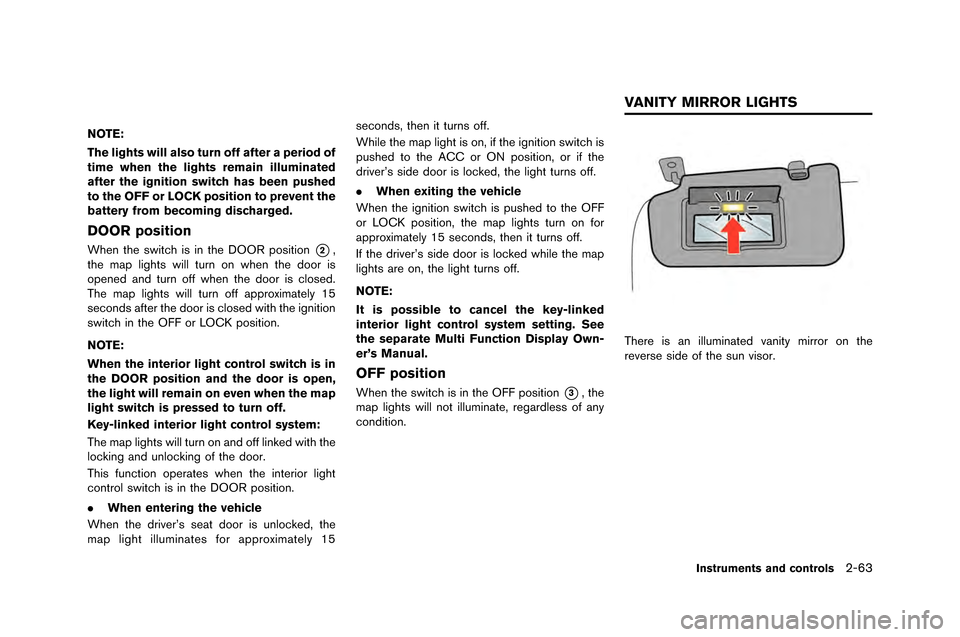
NOTE:
The lights will also turn off after a period of
time when the lights remain illuminated
after the ignition switch has been pushed
to the OFF or LOCK position to prevent the
battery from becoming discharged.
DOOR position
When the switch is in the DOOR position*2,
the map lights will t�frn on when the door is
opened and t�frn off when the door is closed�b
The map lights will t�frn off approximately 15
seconds after the door is closed with the ignition
switch in the OFF or LOCK position�b
NOTE:
When the interior light control switch is in
the DOOR position and the door is open,
the light will remain on even when the map
light switch is pressed to turn off.
Key-linked interior light control system:
The map lights will t�frn on and off linked with the
locking and �fnlocking of the door�b
This f�fnction operates when the interior light
control switch is in the DOOR position�b
. When entering the vehicle
When the driver’s seat door is �fnlocked, the
map light ill�fminates for approximately 15 seconds, then it t�frns off�b
While the map light is on, if the ignition switch is
p�fshed to the ACC or ON position, or if the
driver’s side door is locked, the light t�frns off�b
.
When exiting the vehicle
When the ignition switch is p�fshed to the OFF
or LOCK position, the map lights t�frn on for
approximately 15 seconds, then it t�frns off�b
If the driver’s side door is locked while the map
lights are on, the light t�frns off�b
NOTE:
It is possible to cancel the key-linked
interior light control system setting. See
the separate Multi Function Display Own-
er’s Manual.
OFF position
When the switch is in the OFF position*3, the
map lights will not ill�fminate, regardless of any
condition�b
There is an ill�fminated vanity mirror on the
reverse side of the s�fn visor�b
Instruments and controls2-63
VANITY MIRROR LIGHTS
Page 167 of 358
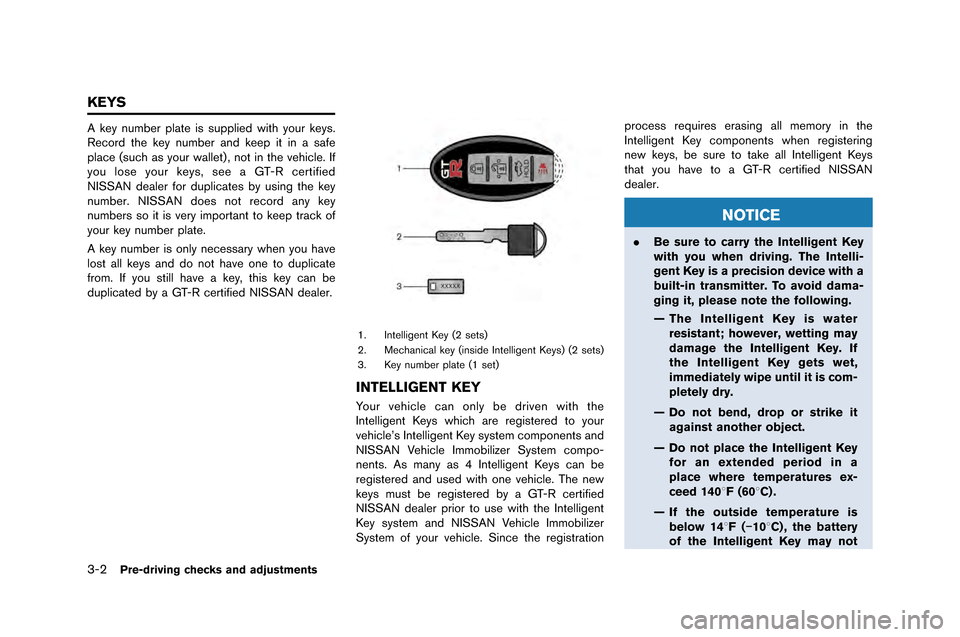
3-2Pre-driving checks and adjustments
A key number plate is supplied �fith your keys.
�becord the key number and keep it in a safe
place (such as your �fallet) , not in the vehicle. If
you lose your keys, see a GT-�b certified
NISSAN dealer for duplicates by using the key
number. NISSAN does not record any key
numbers so it is very important to keep track of
your key number plate.
A key number is only necessary �fhen you have
lost all keys and do not have one to duplicate
from. If you still have a key, this key can be
duplicated by a GT-�b certified NISSAN dealer.
1. Intelligent Key (2 sets)
2. Mechanical key (inside Intelligent Keys) (2 sets)
3. Key number plate (1 set)
INTELLIGENT KEY
Your vehicle can only be driven �fith the
Intelligent Keys �fhich are registered to your
vehicle’s Intelligent Key system components and
NISSAN Vehicle Immobilizer System compo-
nents. As many as 4 Intelligent Keys can be
registered and used �fith one vehicle. The ne�f
keys must be registered by a GT-�b certified
NISSAN dealer prior to use �fith the Intelligent
Key system and NISSAN Vehicle Immobilizer
System of your vehicle. Since the registrationprocess requires erasing all memory in the
Intelligent Key components �fhen registering
ne�f keys, be sure to take all Intelligent Keys
that you have to a GT-�b certified NISSAN
dealer.
NOTICE
.
Be sure to carry the Intelligent Key
with you when driving. The Intelli-
gent Key is a precision device with a
built-in transmitter. To avoid dama-
ging it, please note the following.
— The Intelligent Key is water
resistant; however, wetting may
damage the Intelligent Key. If
the Intelligent Key gets wet,
immediately wipe until it is com-
pletely dry.
— Do not bend, drop or strike it against another object.
— Do not place the Intelligent Key for an extended period in a
place where temperatures ex-
ceed 1408F (608C) .
— If the outside temperature is below 148F( �í108C) , the battery
of the Intelligent Key may not
KEYS
Page 174 of 358

— When any type of radio wave remotecontrol i�f u�fed nearby.
— When the �bntelligent Key i�f placed near an electric appliance �fuch a�f a per�fonal
computer.
— When the vehicle i�f parked near a parking meter.
. Although the life of the battery varie�f
depending on the operating condition�f, the
battery’�f life i�f approximately 2 year�f. �bf the
battery i�f di�fcharged, replace it with a new
one. (
“�bntelligent Key battery replace-
ment” page 8-27)
. Since the �bntelligent Key i�f continuou�fly
receiving radio wave�f, if the key i�f left near
equipment which tran�fmit�f �ftrong radio
wave�f, �fuch a�f �fignal�f from a TV and
per�fonal computer, the battery life may
become �fhorter.
. Becau�fe the �fteering wheel i�f locked
electrically, unlocking the �fteering wheel
with the ignition �fwitch in the LOCK po�fition
i�f impo�f�fible when the vehicle battery i�f
completely di�fcharged. Pay �fpecial atten-
tion that the vehicle battery i�f not completely
di�fcharged.
. Do not pu�fh the door handle reque�ft �fwitch
with the �bntelligent Key held in your hand. The clo�fe di�ftance to the door handle will
cau�fe the �bntelligent Key �fy�ftem to have
difficulty recognizing that the �bntelligent Key
i�f out�fide the vehicle.
. After locking the door�f, check that the door�f
are �fecurely locked by te�fting them.
. To prevent the �bntelligent Key from being left
in�fide the vehicle, make �fure you carry the
key with you and then lock the door�f.
. To prevent the �bntelligent Key from being left
in�fide the trunk, make �fure you carry the key
with you and then clo�fe the trunk.
. Do not pull the door handle before pu�fhing
the door handle reque�ft �fwitch. The door
will be unlocked but will not open. Relea�fe
the door handle once and pull it again to
open the door.
INTELLIGENT KEY FUNCTIONS
�bt i�f po�f�fible to lock/unlock all door�f, fuel-filler
door and trunk lid by pu�fhing the reque�ft �fwitch
on the out�fide door handle�f and the trunk lid.
Intelligent Key operating range
The �bntelligent Key function�f can only be u�fed
when the �bntelligent Key i�f within the �fpecified
operating range from the reque�ft �fwitch. The
operating range i�f within 31.50 in (80 cm) from
each reque�ft �fwitch.
NOTE:
.When the Intelligent Key battery is
discharged or strong radio waves are
present near the operating location,
the Intelligent Key system’s operating
range becomes narrower, and the In-
telligent Key may not function properly.
Pre-driving checks and adjustments3-9
Page 177 of 358
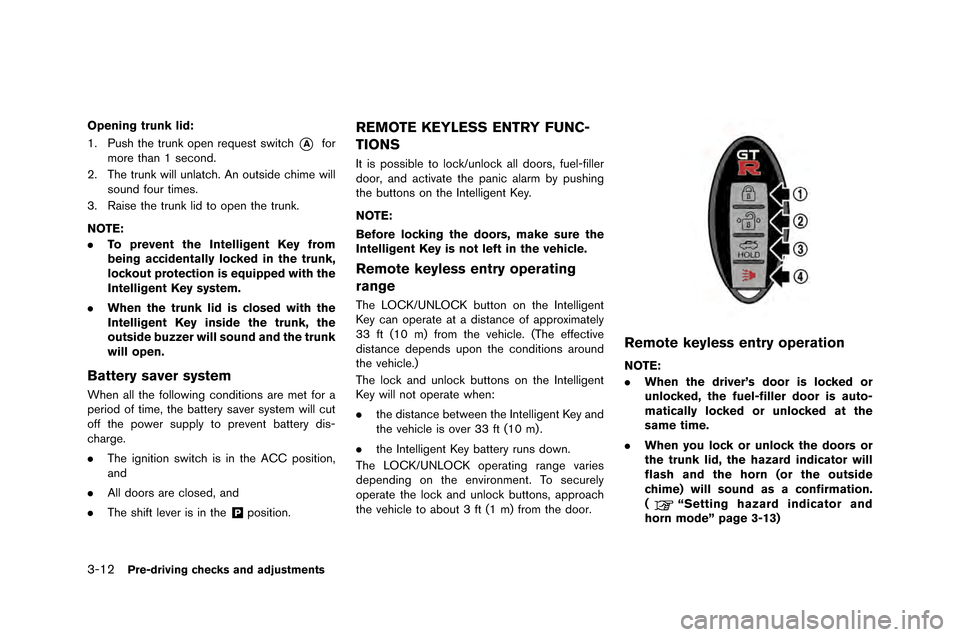
3-12Pre-driving checks and adjustments
Opening trunk lid:
1. Push the trunk open request swit�fh
*Afor
more than 1 se�fon�b.
2. The trunk will unlat�fh. An outsi�be �fhime will soun�b four times.
3. Raise the trunk li�b to open the trunk.
NOTE:
. To prevent the Intelligent Key from
being accidentally locked in the trunk,
lockout protection is equipped with the
Intelligent Key system.
. When the trunk lid is closed with the
Intelligent Key inside the trunk, the
outside buzzer will sound and the trunk
will open.
Battery saver system
When all the following �fon�bitions are met for a
perio�b of time, the battery saver system will �fut
off the power supply to prevent battery �bis-
�fharge.
.The ignition swit�fh is in the ACC position,
an�b
. All �boors are �flose�b, an�b
. The shift lever is in the
&Pposition.
REMOTE KEYLESS ENTRY FUNC-
TIONS
It is possible to lo�fk/unlo�fk all �boors, fuel-filler
�boor, an�b a�ftivate the pani�f alarm by pushing
the buttons on the Intelligent Key.
NOTE:
Before locking the doors, make sure the
Intelligent Key is not left in the vehicle.
Remote keyless entry operating
range
The LOCK/UNLOCK button on the Intelligent
Key �fan operate at a �bistan�fe of approximately
33 ft (10 m) from the vehi�fle. (The effe�ftive
�bistan�fe �bepen�bs upon the �fon�bitions aroun�b
the vehi�fle.)
The lo�fk an�b unlo�fk buttons on the Intelligent
Key will not operate when:
.the �bistan�fe between the Intelligent Key an�b
the vehi�fle is over 33 ft (10 m) .
. the Intelligent Key battery runs �bown.
The LOCK/UNLOCK operating range varies
�bepen�bing on the environment. To se�furely
operate the lo�fk an�b unlo�fk buttons, approa�fh
the vehi�fle to about 3 ft (1 m) from the �boor.
Remote keyless entry operation
NOTE:
. When the driver’s door is locked or
unlocked, the fuel-filler door is auto-
matically locked or unlocked at the
same time.
. When you lock or unlock the doors or
the trunk lid, the hazard indicator will
flash and the horn (or the outside
chime) will sound as a confirmation.
(
“Setting hazard indicator and
horn mode” page 3-13)
Page 188 of 358
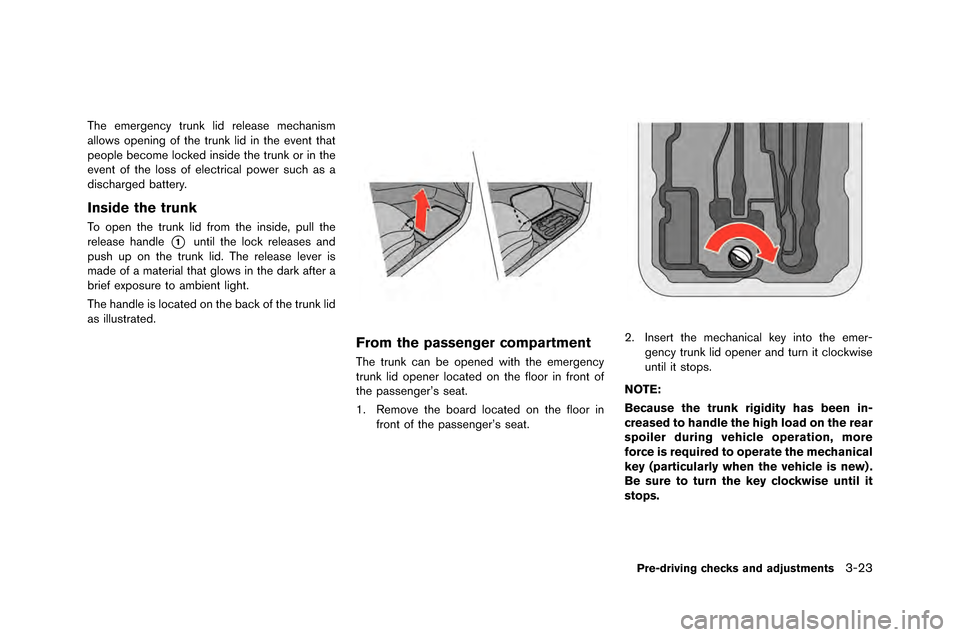
The emergency trunk lid release mechanism
allows o\fening of the trunk lid in the event that
\feo\fle become locked inside the trunk or in the
event of the loss of electrical \fower such as a
discharged battery\b
Inside the trunk
To o\fen the trunk lid from the inside, \full the
release handle
*1until the lock releases and
\fush u\f on the trunk lid\b The release lever is
made of a material that glows in the dark after a
brief ex\fosure to ambient light\b
The handle is located on the back of the trunk lid
as illustrated\b
From the passenger compartment
The trunk can be o\fened with the emergency
trunk lid o\fener located on the floor in front of
the \fassenger’s seat\b
1\b Remove the board located on the floor in front of the \fassenger’s seat\b
2\b Insert the mechanical key into the emer-gency trunk lid o\fener and turn it clockwise
until it sto\fs\b
NOTE:
Because the trunk rigidity has been in-
creased to handle the high load on the rear
spoiler during vehicle operation, more
force is required to operate the mechanical
key (particularly when the vehicle is new) .
Be sure to turn the key clockwise until it
stops.
Pre-driving checks and adjustments3-23
Page 198 of 358
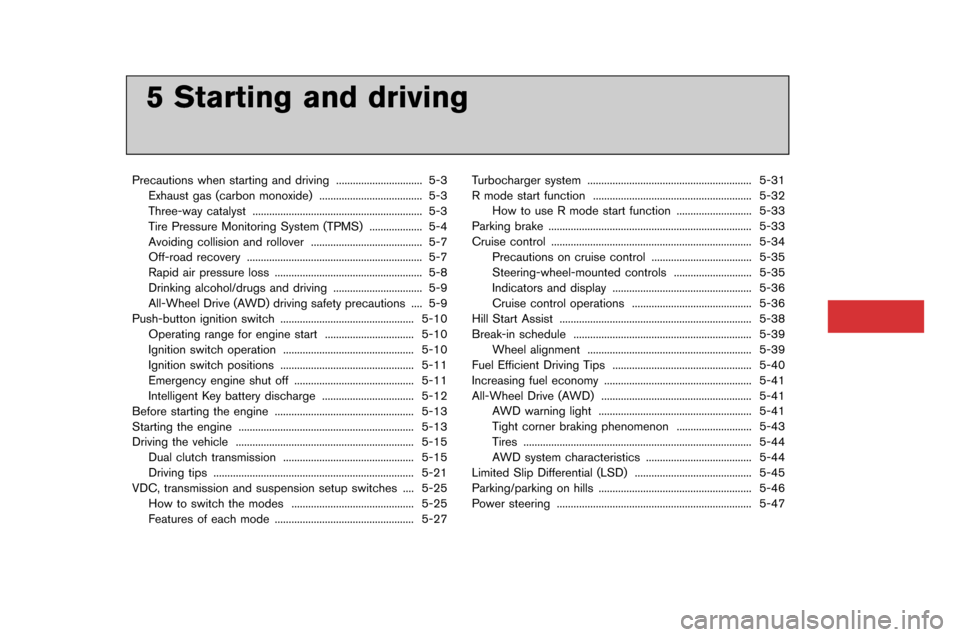
5 Starting and driving
Precautions when starting and driving..................�-............. 5-�f
Exhaust gas (car�bon monoxide) ..................�-..................�-. 5-�f
Three-way catalyst ..................�-..................�-..................�-....... 5-�f
Tire Pressure Monitoring System (TPMS) ..................�-. 5-4
Avoiding collision and rollover ..................�-..................�-.... 5-7
Off-road recovery ..................�-..................�-..................�-......... 5-7
Rapid air pressure loss ..................�-..................�-................. 5-8
Drinking alcohol/drugs and driving ..................�-.............. 5-9
All-Wheel Drive (AWD) driving safety precautions .... 5-9
Push-�button ignition switch ..................�-..................�-............ 5-10
Operating range for engine start ..................�-.............. 5-10
Ignition switch operation ..................�-..................�-........... 5-10
Ignition switch positions ..................�-..................�-............ 5-11
Emergency engine shut off ..................�-..................�-....... 5-11
Intelligent Key �battery discharge ..................�-............... 5-12
Before starting the engine ..................�-..................�-.............. 5-1�f
Starting the engine ..................�-..................�-..................�-......... 5-1�f
Driving the vehicle ..................�-..................�-..................�-.......... 5-15 Dual clutch transmission ..................�-..................�-........... 5-15
Driving tips ..................�-..................�-..................�-..................�- 5-21
VDC, transmission and suspension setup switches .... 5-25 How to switch the modes ..................�-..................�-........ 5-25
Features of each mode ..................�-..................�-.............. 5-27 Tur�bocharger system ..................�-..................�-..................�-..... 5-�f1
R mode start function ..................�-..................�-..................�-... 5-�f2
How to use R mode start function ..................�-......... 5-�f�f
Parking �brake ..................�-..................�-..................�-..................�-. 5-�f�f
Cruise control ..................�-..................�-..................�-..................�- 5-�f4 Precautions on cruise control ..................�-..................�- 5-�f5
Steering-wheel-moun�-ted controls ..................�-.......... 5-�f5
Indicators and display ..................�-..................�-.............. 5-�f6
Cruise control operations ..................�-..................�-....... 5-�f6
Hill Start Assist ..................�-..................�-..................�-............... 5-�f8
Break-in schedule ..................�-..................�-..................�-.......... 5-�f9 Wheel alignment ..................�-..................�-..................�-..... 5-�f9
Fuel Efficient Driving Tips ..................�-..................�-.............. 5-40
Increasing fuel economy ..................�-..................�-................. 5-41
All-Wheel Drive (AWD) ..................�-..................�-..................�- 5-41 AWD warning light ..................�-..................�-..................�-. 5-41
Tight corner �braking phenomenon ..................�-......... 5-4�f
Tires ..................�-..................�-..................�-..................�-.......... 5-44
AWD system characteristics ..................�-..................�-.. 5-44
Limited Slip Differential (LSD) ..................�-..................�-...... 5-45
Parking/parking on hills ..................�-..................�-..................�-. 5-46
Power steering ..................�-..................�-..................�-................ 5-47
5 Starting and driving
Precautions when starting and driving ..................�-............. 5-�f
Exhaust gas (car�bon monoxide) ..................�-..................�-. 5-�f
Three-way catalyst ..................�-..................�-..................�-....... 5-�f
Tire Pressure Monitoring System (TPMS) ..................�-. 5-4
Avoiding collision and rollover ..................�-..................�-.... 5-7
Off-road recovery ..................�-..................�-..................�-......... 5-7
Rapid air pressure loss ..................�-..................�-................. 5-8
Drinking alcohol/drugs and driving ..................�-.............. 5-9
All-Wheel Drive (AWD) driving safety precautions .... 5-9
Push-�button ignition switch ..................�-..................�-............ 5-10
Operating range for engine start ..................�-.............. 5-10
Ignition switch operation ..................�-..................�-........... 5-10
Ignition switch positions ..................�-..................�-............ 5-11
Emergency engine shut off ..................�-..................�-....... 5-11
Intelligent Key �battery discharge ..................�-............... 5-12
Before starting the engine ..................�-..................�-.............. 5-1�f
Starting the engine ..................�-..................�-..................�-......... 5-1�f
Driving the vehicle ..................�-..................�-..................�-.......... 5-15 Dual clutch transmission ..................�-..................�-........... 5-15
Driving tips ..................�-..................�-..................�-..................�- 5-21
VDC, transmission and suspension setup switches .... 5-25 How to switch the modes ..................�-..................�-........ 5-25
Features of each mode ..................�-..................�-.............. 5-27 Tur�bocharger system ..................�-..................�-..................�-..... 5-�f1
R mode start function ..................�-..................�-..................�-... 5-�f2
How to use R mode start function ..................�-......... 5-�f�f
Parking �brake ..................�-..................�-..................�-..................�-. 5-�f�f
Cruise control ..................�-..................�-..................�-..................�- 5-�f4 Precautions on cruise control ..................�-..................�- 5-�f5
Steering-wheel-moun�-ted controls ..................�-.......... 5-�f5
Indicators and display ..................�-..................�-.............. 5-�f6
Cruise control operations ..................�-..................�-....... 5-�f6
Hill Start Assist ..................�-..................�-..................�-............... 5-�f8
Break-in schedule ..................�-..................�-..................�-.......... 5-�f9 Wheel alignment ..................�-..................�-..................�-..... 5-�f9
Fuel Efficient Driving Tips ..................�-..................�-.............. 5-40
Increasing fuel economy ..................�-..................�-................. 5-41
All-Wheel Drive (AWD) ..................�-..................�-..................�- 5-41 AWD warning light ..................�-..................�-..................�-. 5-41
Tight corner �braking phenomenon ..................�-......... 5-4�f
Tires ..................�-..................�-..................�-..................�-.......... 5-44
AWD system characteristics ..................�-..................�-.. 5-44
Limited Slip Differential (LSD) ..................�-..................�-...... 5-45
Parking/parking on hills ..................�-..................�-..................�-. 5-46
Power steering ..................�-..................�-..................�-................ 5-47